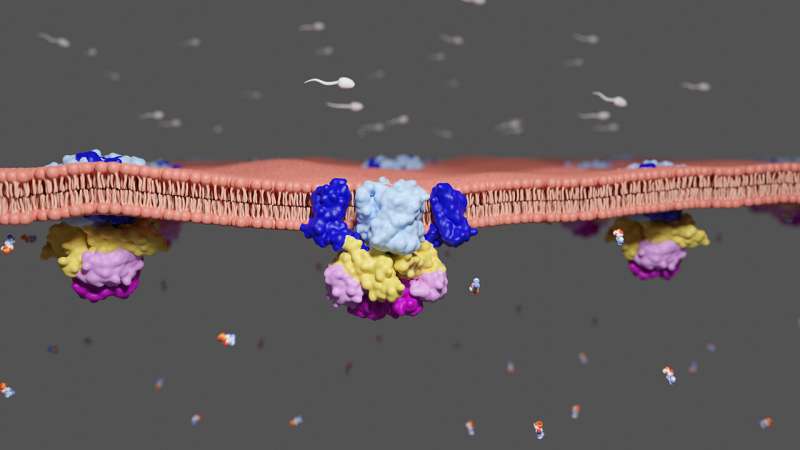This article has been reviewed according to Science X's editorial process and policies. Editors have highlighted the following attributes while ensuring the content's credibility:
fact-checked
peer-reviewed publication
trusted source
proofread
Membrane transporter ensures mobility of sperm cells, study finds

Special proteins known as membrane transporters are of key importance for the mobility of sperm cells. A research team from the Heidelberg University Biochemistry Center (BZH) headed by Prof. Dr. Cristina Paulino has, with the aid of cryo-electron microscopy, for the first time succeeded in decoding the structure of such a transporter and its mechanism.
According to the researchers, these findings, now published in Nature, will enable a better understanding of the molecular foundations of reproductive capacity and could, in the long term, contribute to developing new approaches to treating fertility disorders and new methods of specific contraception.
Sperm cells differ fundamentally in structure and function from other cell types. After all, their only task is to track down and fuse with the egg. Sperm cells only achieve their full activity in what is called capacitation, which means the maturing of the cells in the semen. One of the final steps of this biochemical process involves increasing the sperm's mobility. If the cells are not able to move autonomously, or only to a limited extent, the result is generally reduced fertility or a complete lack of reproductive capacity. The sperm cells cannot reach and fertilize the egg cell.
Within this final maturation process, special proteins found in the sperm membrane have a particular role. Known as membrane transporters, they are responsible for transporting nutrients, for instance, into or out of the cell. "Transporting certain ions into the cell leads to a rise in sperm mobility. For that reason, the proteins responsible for the transport are directly linked to the fertility of a sperm and thereby with the male capacity for reproduction," Paulino says. Her research group at the BZH is working on the membrane transporters of sea urchins, a model system for investigating sperm.
With the assistance of cryo-electron microscopy, the scientists have now been able to decode the structure of an important sperm membrane transporter at the molecular level. Among other things, they discovered what its functional units look like, and how they interconnect and interact.
"We have observed that the key protein is, like a Lego toy, constructed from different building units. These building blocks are basically known from other proteins, but have never been observed in such a combination. With the aid of this information, we were able to decode the mechanism of this transporter for the first time," explains Dr. Valeria Kalienkova from the University of Bergen (Norway), a former member of Paulino's research group.
According to Dr. Martin Peter, a member of Paulino's research team, these new findings will be helpful in the next step, developing potential substances that influence this mechanism. They may make it possible to activate or deactivate the functions of the proteins. The extent to which these findings can be transferred to the mechanisms of human sperm will call for further investigation. In the long term, they contain potential for finding new ways of treating infertility, or vice versa, of preventing the sperm from fertilizing the egg cell.
More information: Valeria Kalienkova et al, Structures of a sperm-specific solute carrier gated by voltage and cAMP, Nature (2023). DOI: 10.1038/s41586-023-06629-w
Journal information: Nature
Provided by Heidelberg University




















